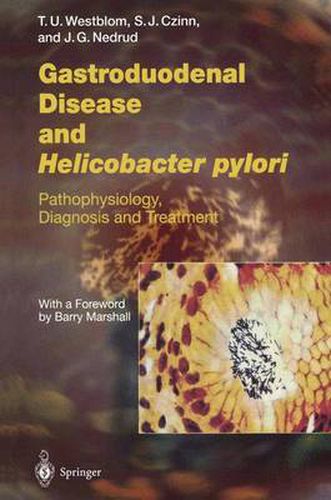Readings Newsletter
Become a Readings Member to make your shopping experience even easier.
Sign in or sign up for free!
You’re not far away from qualifying for FREE standard shipping within Australia
You’ve qualified for FREE standard shipping within Australia
The cart is loading…






This title is printed to order. This book may have been self-published. If so, we cannot guarantee the quality of the content. In the main most books will have gone through the editing process however some may not. We therefore suggest that you be aware of this before ordering this book. If in doubt check either the author or publisher’s details as we are unable to accept any returns unless they are faulty. Please contact us if you have any questions.
I am delighted to be able to write the foreword for this new book on Helicobacter pylori by three pioneers in the field, Vlf West blom, Steven Czinn and John Nedrud. Because of their long experience in both basic and clinical aspects of H. pylori, the editors have been able to produce a volume which is authoritative and up to date in the science of H. pylori, while still being concise and interesting for the practicing physician or H. pylori novice. To achieve this, they have collected a very distinguished group of authors from within the Vnited States and around the world. The chapters are sequenced in approximately the same order as developments in H. pylori science over the past 15 years. The first chapter on the discovery of H. pylori is by Cliodna McNulty, who was the first person to culture the organism in Europe. The epidemiology is then described followed by the main clinical as sociations, which are gastritis and dyspepsia, peptic ulcers, can cers and lymphoma. This naturally leads to discussion of the laboratory aspects of H. pylori, especially the microbiology, in cluding essential information on antibiotic resistance patterns. Next, virulence and pathogenicity of H. pylori are explained as defined in studies using animal models, then by discussion of the metabolism of the organism. Finally, the interaction of the bac terium with the host immune systems is dealt with, including the implications of these findings as they relate to the development of future vaccines.
$9.00 standard shipping within Australia
FREE standard shipping within Australia for orders over $100.00
Express & International shipping calculated at checkout
This title is printed to order. This book may have been self-published. If so, we cannot guarantee the quality of the content. In the main most books will have gone through the editing process however some may not. We therefore suggest that you be aware of this before ordering this book. If in doubt check either the author or publisher’s details as we are unable to accept any returns unless they are faulty. Please contact us if you have any questions.
I am delighted to be able to write the foreword for this new book on Helicobacter pylori by three pioneers in the field, Vlf West blom, Steven Czinn and John Nedrud. Because of their long experience in both basic and clinical aspects of H. pylori, the editors have been able to produce a volume which is authoritative and up to date in the science of H. pylori, while still being concise and interesting for the practicing physician or H. pylori novice. To achieve this, they have collected a very distinguished group of authors from within the Vnited States and around the world. The chapters are sequenced in approximately the same order as developments in H. pylori science over the past 15 years. The first chapter on the discovery of H. pylori is by Cliodna McNulty, who was the first person to culture the organism in Europe. The epidemiology is then described followed by the main clinical as sociations, which are gastritis and dyspepsia, peptic ulcers, can cers and lymphoma. This naturally leads to discussion of the laboratory aspects of H. pylori, especially the microbiology, in cluding essential information on antibiotic resistance patterns. Next, virulence and pathogenicity of H. pylori are explained as defined in studies using animal models, then by discussion of the metabolism of the organism. Finally, the interaction of the bac terium with the host immune systems is dealt with, including the implications of these findings as they relate to the development of future vaccines.